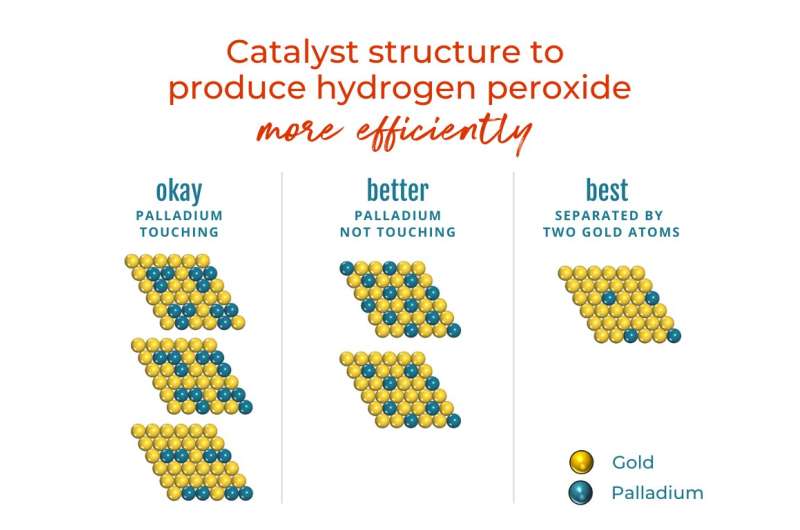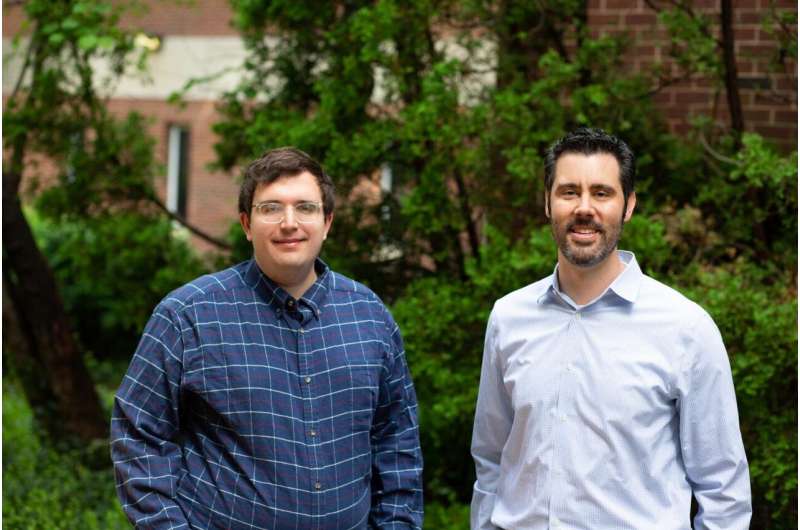Scientists demonstrate a better, more eco-friendly method to produce hydrogen peroxide

Hydrogen peroxide (H2O2) is used to disinfect minor cuts at home and for oxidative reactions in industrial manufacturing. Now, the pandemic has further fueled demand for this chemical and its antiseptic properties. While affordable at the grocery store, H2O2 is actually difficult and expensive to manufacture at scale.
A team led by the University of Illinois Urbana-Champaign has demonstrated a more efficient and environmentally friendly method to produce H2O2, according to a recent study published in the Journal of the American Chemical Society.
"While the two ingredients—hydrogen and oxygen—are either inexpensive or freely available from the atmosphere, hydrogen peroxide is highly reactive and unstable, which makes it very hard to produce," said first author Tomas Ricciardulli, a graduate student in chemical and biomolecular engineering at UIUC.
Currently, producing H2O2 requires a complicated, multi-step process and large facilities. Moreso, this traditional method relies on an intermediate chemical (anthraquinone) that is derived from fossil fuels.
Decades ago, researchers proposed a simpler, cheaper, and 'greener' one-step alternative method where a catalyst (palladium-gold nanoparticles) drives the reaction instead. Bonus: the catalyst can be recycled to produce hydrogen peroxide over and over.
"However, hydrogen and oxygen also form water, and this proposed 'direct synthesis' method was known to synthesize 80 percent water and just 20 percent hydrogen peroxide," said lead author David Flaherty, a professor of chemical and biomolecular engineering at UIUC. "Scientists have fiercely debated the arrangement of palladium and gold atoms needed in nanoparticles to increase the selectivity for hydrogen peroxide and why this works."
A higher ratio of gold to palladium atoms in the catalyst produces more H2O2 and less water. The researchers found that a catalyst with a ratio of one palladium to 220 gold atoms generates almost 100 percent hydrogen peroxide, which is about the point of diminishing returns.

Significantly, the catalysts give stable performance over many days of use, continuously achieve these remarkable selectivities to H2O2, and do so using clean water as a solvent, which avoids the problematic and corrosive additives often used for this chemistry.
The organization of these atoms within the catalyst also counts: palladium atoms touching one another favor water formation, while palladium atoms surrounded by gold favor H2O2 formation.
What's more, they discovered the influence extends from the first ring of neighboring atoms that surround the palladium atom to the second layer of atoms, called the next nearest neighbors. More H2O2 is synthesized when both a given palladium atom's neighbors and next-nearest neighbors are all gold.
"We demonstrated how to create a very efficient and selective catalyst," said Flaherty, who is also a Dow Chemical Company Faculty Scholar. "While promising, there are still hurdles to overcome to adopt this method commercially."
The Flaherty research group is pursuing the development of nanoparticle catalysts with new compositions and reactors to enable hybrid chemical-electrochemical methods for this reaction. "Our ultimate goal is to develop feasible technology for distributed production of H2O2 which would open doors for many sustainable alternatives to traditional chemical processes."
The researchers also expect that their activities will reveal other key scientific concepts to electrify chemical manufacturing along the way.
More information: Tomas Ricciardulli et al, Effect of Pd Coordination and Isolation on the Catalytic Reduction of O2 to H2O2 over PdAu Bimetallic Nanoparticles, Journal of the American Chemical Society (2021). DOI: 10.1021/jacs.1c00539
Journal information: Journal of the American Chemical Society
Provided by University of Illinois at Urbana-Champaign




















